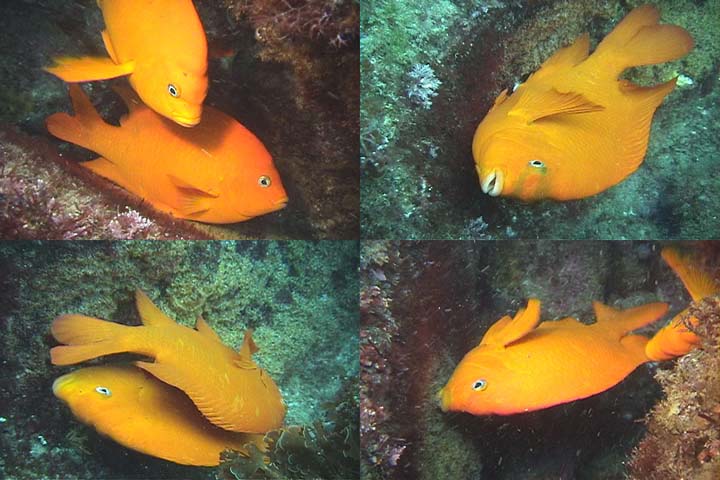

I returned from my college reunion two weeks ago, but forgot to submit a column last week. By the way- Al Gore and Tommy Lee Jones never showed up, so I guess they never amounted to much. Hard to believe it has been two years and more than 600 dives since I started writing these columns. I wanted to say I appreciate all the nice comments I get from readers. Today I've decided to revisit my very first column about "Caleeforneeya's" state salt water fish, the garibaldi. These amusing animals have been very active lately since, once again, it is mating season!
Throughout the dive park (and the rest of their range) males are defending nests they established in late spring. As I dive through the shallower areas of the park, I am frequently "attacked" by them... indicating I've come close to a nest. "Close" is a relative term and seems to depend on the state of any eggs in the nest and the aggressiveness of that particular male. Some nests are red due to the red algae garibaldis promote to lay the eggs on. This red color indicates there are no new eggs in the nest. Nests which have bright yellow-green circular patches have had fresh eggs laid in them. Those with a dull gray color have older eggs that are developing. Nests with eggs in them are defended much more actively.
As I dive, I keep my eyes open for a male soliciting females to enter his nest. They do so by making a clicking sound and swimming in tight (3-6 foot) oval patterns referred to as "dipping." It reminds me of the Allan's hummingbird mating flight. Maybe we humans need to imitate these two successful patterns. The female decides if she will lay based on the status of the nest. If there are fresh yellow-green eggs, she is much more likely to add her eggs to those from other females since they will be well-defended. If there are no eggs or only older gray eggs, she is less likely to respond to the male since her eggs may not be well defended once the older eggs hatch.
When I see any of this activity, I slowly swim over to the nest with camera rolling. I try to patiently work my way closer to the nest for a better shot, allowing the pair to get acclimated to my presence. Fortunately, in the throes of passion, the male seems much less interested in me than in the female! I've managed to get very close to the action, acquiring great footage over periods of several minutes. However, sometimes I approach too close and scare the female out of the nest... leaving a slightly perturbed male facing me off. The female will slowly swim in circles close to the rest with her eggs extruding from her body. The male will swim near her, defending her and the eggs. Then occasionally it will swim in beside her and release his sperm to fertilize the eggs.
Males may entice several females into their nest this way, especially after the first has laid her eggs making the nest more appealing to other females. Each may lay 15,-90,000 eggs so there may be quite a mess, er I mean mass, in a well-visited nest. Towards the end of her egg-laying visit, the female will often attempt to eat some of the eggs in the nest. I can't tell if she eats her own (which would make little sense) or those laid earlier by a "competing" female. At this point the male starts clicking again and chases her out of the nest.
The male then "tends" the nest ("a man's work is never done"). He may be observed weeding unwanted algae from the red submarine garden he has created. One of my favorite nests to film was not used this year. It is covered with "weeds" (non-red algae) of different colors. Perhaps the male who used this nest died over the winter. Males may swim slowly over the eggs using his fins and movement to circulate seawater with more oxygen over them to help ensure their survival. And of course he will chase potential egg predators including senoritas and other garibaldi from the nest area. I often observe males allowing kelp bass to enter the territory or approach the nest without being attacked. Presumably they do not eat the eggs, and the garibaldi doesn't want to waste energy unnecessarily since the males do not eat often during egg brooding and nest defense. The eggs will hatch in 2-3 weeks as larvae that will drift with the currents to new locations.
This summer I will be editing new video programs targeted for mainland cable and "mainstream" television stations. Since I dive solo most of the time, my "buddy" in these productions will be none other than Gary Baldi himself. Gary's voice will be provided by none other than Herbie Sadd of Catalina Auto & Bike Rentals fame. That should add a new element of humor to my videos, allowing me to play the "straight" man with the objective, scientific mind. Yeah, right. My other project this summer will be to finally meet the mermaid of my dreams and sail off into the sunset to dive South America, Africa and revisit previously dived international tropical sites after our own waters cool. Yeah, right!!
© 2004 Dr. Bill Bushing. Watch the "Dive Dry with Dr. Bill" underwater videos on Catalina Cable TV channel 49, 10:00 AM and 5:00 PM weekdays.

Male watching as female lays; female laying eggs in
nest; male alongside female
fertilizing the eggs; female starting to
eat eggs before being chased out.
This document maintained by
Dr. Bill Bushing.
Material
© 2004 Star Thrower Educational Multimedia